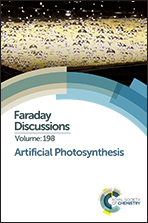Temperature dependence of photocatalytic CO2 reduction by trans(Cl)–Ru(bpy)(CO)2Cl2: activation energy difference between CO and formate production†
Abstract
The temperature dependence of photocatalytic CO2 reduction by trans(Cl)–Ru(bpy)(CO)2Cl2 (bpy: 2,2′-bipyridine) has been researched in ethanol (EtOH)/N,N-dimethylacetamide (DMA) solutions containing [Ru(bpy)3]2+ (a photosensitizer) and 1-benzyl-1,4-dihydronicotinamide (BNAH, an electron donor). The catalytic system efficiently reduces CO2 to carbon monoxide (CO) with formate (HCOO−) as a minor product. The mechanism of the catalysis consists of the electron-relay cycle and the catalytic cycle: in the former cycle the photochemically generated reduced species of the photosensitizer injects an electron to the catalyst, and in the latter the catalyst reduces CO2. At a low concentration of the catalyst (5.0 μM), where the catalytic cycle is rate-determining, the temperature dependence of CO/HCOO− is also dependent on the EtOH contents: the selectivity of CO/HCOO− decreases in 20% and 40%-EtOH/DMA with increasing temperature, while it increases in 60%-EtOH/DMA. The temperature dependence of the CO/HCOO− selectivity indicates that the difference in activation energy (ΔΔG‡) between CO and HCOO− production is estimated as ca. 3.06 kJ mol−1 in 40%-EtOH/DMA at 298 K.
- This article is part of the themed collection: Artificial Photosynthesis

 Please wait while we load your content...
Please wait while we load your content...